


File photo taken on July 20, 2021 shows Penjig checking saplings at his nursery in Zhanang County, Shannan City of southwest China's Tibet Autonomous Region.
The middle reaches of the Yarlung Zangbo River, once stretches of barren land with sandstorms raging in spring and winter, now see a sea of green trees all over the place.
With unwavering endeavors of sand control and ecology restoration, more than 45 million trees have been planted over the past four decades in Shannan, an area the Yarlung Zangbo River runs through.
In 1967, Li Chunlu, an agricultural school graduate from northwest China's Gansu Province, was assigned to work in Shannan. On his way to work, the 24-year-old was inundated by the yellow dust in the air. Li thought, at the time, how good it would be if trees could be planted here.
An ambition of planting trees was bred in Li Chunlu as a boy named Penjig from a village by the Yarlung Zangbo River planted a few willow branches on the hillside where he grazed his sheep. The willow branches survived and then grew into willow trees.
In 1982, Li Chunlu shifted his work to the forestry section of the local agriculture and animal husbandry bureau. He tried to start planting trees along the river. However, it was too difficult for the trees to survive due to the drought in spring and winter and the flood during summer and autumn.
In 1984, Li Chunlu and his colleagues finally worked out tree-planting techniques along the riverside, which led to their success of growing about 800 mu (53.3 hectares) of experimental forest.
In the 1990s, the afforestation project was further expanded. Li Chunlu, who was responsible for the forestation work, selected Penjig, who had already grown up as an adult, as one of the team leaders to oversee a tree-planting project because of his relevant experience. Together with 12 villagers, the team was jointly engaged in the restoration project along the river.
Local villagers joined the forestation work as their side business to increase their income at first. Later, they were a lot more motivated to grow trees as they witnessed less sand and agricultural disasters thanks to the afforestation effort. Crop yield has thus been boosted, while pasture has been gradually expanded with more cattle and sheep raised.
In 2004, with the support of the local government, Penjig, who had more than 10 years of experience in tree planting, built his own nursery.
Today, more and more people are taking part in this campaign, and the riverside of the middle reaches of Yarlung ZangBo River has been lush and green. (Xinhua/Jigme Dorje)
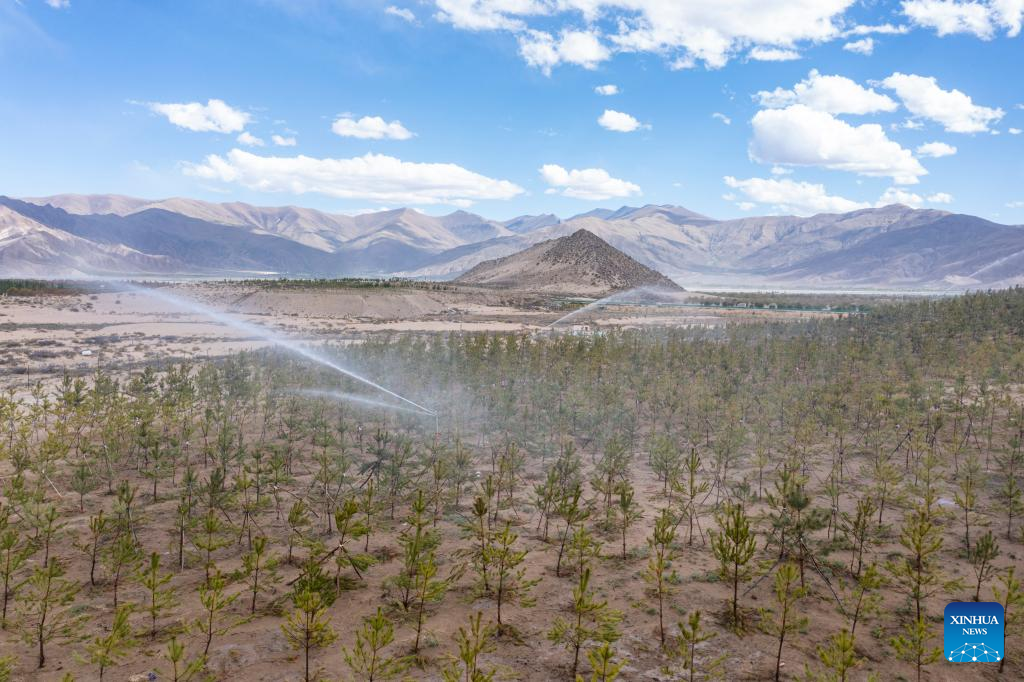
Aerial photo taken on May 26, 2022 shows the afforestation area by the Yarlung Zangbo River in Shannan City of southwest China's Tibet Autonomous Region.
The middle reaches of the Yarlung Zangbo River, once stretches of barren land with sandstorms raging in spring and winter, now see a sea of green trees all over the place.
With unwavering endeavors of sand control and ecology restoration, more than 45 million trees have been planted over the past four decades in Shannan, an area the Yarlung Zangbo River runs through.
In 1967, Li Chunlu, an agricultural school graduate from northwest China's Gansu Province, was assigned to work in Shannan. On his way to work, the 24-year-old was inundated by the yellow dust in the air. Li thought, at the time, how good it would be if trees could be planted here.
An ambition of planting trees was bred in Li Chunlu as a boy named Penjig from a village by the Yarlung Zangbo River planted a few willow branches on the hillside where he grazed his sheep. The willow branches survived and then grew into willow trees.
In 1982, Li Chunlu shifted his work to the forestry section of the local agriculture and animal husbandry bureau. He tried to start planting trees along the river. However, it was too difficult for the trees to survive due to the drought in spring and winter and the flood during summer and autumn.
In 1984, Li Chunlu and his colleagues finally worked out tree-planting techniques along the riverside, which led to their success of growing about 800 mu (53.3 hectares) of experimental forest.
In the 1990s, the afforestation project was further expanded. Li Chunlu, who was responsible for the forestation work, selected Penjig, who had already grown up as an adult, as one of the team leaders to oversee a tree-planting project because of his relevant experience. Together with 12 villagers, the team was jointly engaged in the restoration project along the river.
Local villagers joined the forestation work as their side business to increase their income at first. Later, they were a lot more motivated to grow trees as they witnessed less sand and agricultural disasters thanks to the afforestation effort. Crop yield has thus been boosted, while pasture has been gradually expanded with more cattle and sheep raised.
In 2004, with the support of the local government, Penjig, who had more than 10 years of experience in tree planting, built his own nursery.
Today, more and more people are taking part in this campaign, and the riverside of the middle reaches of Yarlung ZangBo River has been lush and green. (Xinhua/Sun Fei)

Aerial photo taken on May 27, 2022 shows the Yarlung Zangbo River flowing past Shannan City of southwest China's Tibet Autonomous Region.
The middle reaches of the Yarlung Zangbo River, once stretches of barren land with sandstorms raging in spring and winter, now see a sea of green trees all over the place.
With unwavering endeavors of sand control and ecology restoration, more than 45 million trees have been planted over the past four decades in Shannan, an area the Yarlung Zangbo River runs through.
In 1967, Li Chunlu, an agricultural school graduate from northwest China's Gansu Province, was assigned to work in Shannan. On his way to work, the 24-year-old was inundated by the yellow dust in the air. Li thought, at the time, how good it would be if trees could be planted here.
An ambition of planting trees was bred in Li Chunlu as a boy named Penjig from a village by the Yarlung Zangbo River planted a few willow branches on the hillside where he grazed his sheep. The willow branches survived and then grew into willow trees.
In 1982, Li Chunlu shifted his work to the forestry section of the local agriculture and animal husbandry bureau. He tried to start planting trees along the river. However, it was too difficult for the trees to survive due to the drought in spring and winter and the flood during summer and autumn.
In 1984, Li Chunlu and his colleagues finally worked out tree-planting techniques along the riverside, which led to their success of growing about 800 mu (53.3 hectares) of experimental forest.
In the 1990s, the afforestation project was further expanded. Li Chunlu, who was responsible for the forestation work, selected Penjig, who had already grown up as an adult, as one of the team leaders to oversee a tree-planting project because of his relevant experience. Together with 12 villagers, the team was jointly engaged in the restoration project along the river.
Local villagers joined the forestation work as their side business to increase their income at first. Later, they were a lot more motivated to grow trees as they witnessed less sand and agricultural disasters thanks to the afforestation effort. Crop yield has thus been boosted, while pasture has been gradually expanded with more cattle and sheep raised.
In 2004, with the support of the local government, Penjig, who had more than 10 years of experience in tree planting, built his own nursery.
Today, more and more people are taking part in this campaign, and the riverside of the middle reaches of Yarlung ZangBo River has been lush and green. (Xinhua/Sun Fei)
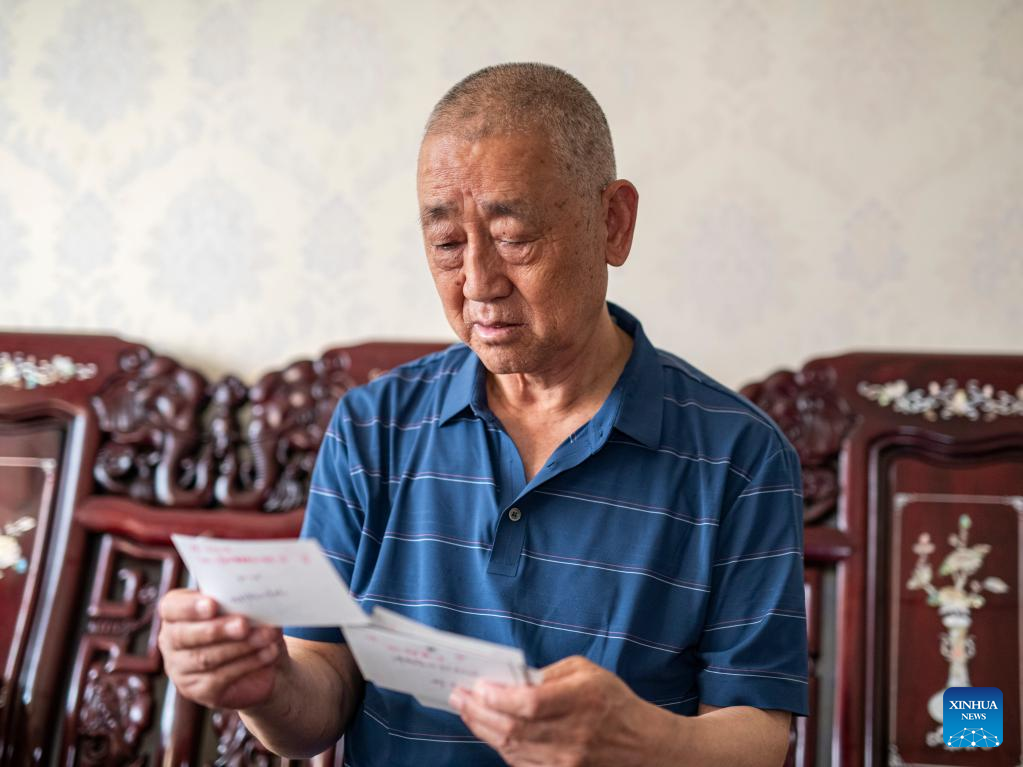
Retired Li Chunlu views old photos at home in Chengdu City, southwest China's Sichuan Province, June 3, 2022.
The middle reaches of the Yarlung Zangbo River, once stretches of barren land with sandstorms raging in spring and winter, now see a sea of green trees all over the place.
With unwavering endeavors of sand control and ecology restoration, more than 45 million trees have been planted over the past four decades in Shannan, an area the Yarlung Zangbo River runs through.
In 1967, Li Chunlu, an agricultural school graduate from northwest China's Gansu Province, was assigned to work in Shannan. On his way to work, the 24-year-old was inundated by the yellow dust in the air. Li thought, at the time, how good it would be if trees could be planted here.
An ambition of planting trees was bred in Li Chunlu as a boy named Penjig from a village by the Yarlung Zangbo River planted a few willow branches on the hillside where he grazed his sheep. The willow branches survived and then grew into willow trees.
In 1982, Li Chunlu shifted his work to the forestry section of the local agriculture and animal husbandry bureau. He tried to start planting trees along the river. However, it was too difficult for the trees to survive due to the drought in spring and winter and the flood during summer and autumn.
In 1984, Li Chunlu and his colleagues finally worked out tree-planting techniques along the riverside, which led to their success of growing about 800 mu (53.3 hectares) of experimental forest.
In the 1990s, the afforestation project was further expanded. Li Chunlu, who was responsible for the forestation work, selected Penjig, who had already grown up as an adult, as one of the team leaders to oversee a tree-planting project because of his relevant experience. Together with 12 villagers, the team was jointly engaged in the restoration project along the river.
Local villagers joined the forestation work as their side business to increase their income at first. Later, they were a lot more motivated to grow trees as they witnessed less sand and agricultural disasters thanks to the afforestation effort. Crop yield has thus been boosted, while pasture has been gradually expanded with more cattle and sheep raised.
In 2004, with the support of the local government, Penjig, who had more than 10 years of experience in tree planting, built his own nursery.
Today, more and more people are taking part in this campaign, and the riverside of the middle reaches of Yarlung ZangBo River has been lush and green. (Xinhua/Tang Wenhao)

Penjig checks the growth of a sapling at the afforestation area by the Yarlung Zangbo River in Zhanang County, Shannan City of southwest China's Tibet Autonomous Region, May 26, 2022.
The middle reaches of the Yarlung Zangbo River, once stretches of barren land with sandstorms raging in spring and winter, now see a sea of green trees all over the place.
With unwavering endeavors of sand control and ecology restoration, more than 45 million trees have been planted over the past four decades in Shannan, an area the Yarlung Zangbo River runs through.
In 1967, Li Chunlu, an agricultural school graduate from northwest China's Gansu Province, was assigned to work in Shannan. On his way to work, the 24-year-old was inundated by the yellow dust in the air. Li thought, at the time, how good it would be if trees could be planted here.
An ambition of planting trees was bred in Li Chunlu as a boy named Penjig from a village by the Yarlung Zangbo River planted a few willow branches on the hillside where he grazed his sheep. The willow branches survived and then grew into willow trees.
In 1982, Li Chunlu shifted his work to the forestry section of the local agriculture and animal husbandry bureau. He tried to start planting trees along the river. However, it was too difficult for the trees to survive due to the drought in spring and winter and the flood during summer and autumn.
In 1984, Li Chunlu and his colleagues finally worked out tree-planting techniques along the riverside, which led to their success of growing about 800 mu (53.3 hectares) of experimental forest.
In the 1990s, the afforestation project was further expanded. Li Chunlu, who was responsible for the forestation work, selected Penjig, who had already grown up as an adult, as one of the team leaders to oversee a tree-planting project because of his relevant experience. Together with 12 villagers, the team was jointly engaged in the restoration project along the river.
Local villagers joined the forestation work as their side business to increase their income at first. Later, they were a lot more motivated to grow trees as they witnessed less sand and agricultural disasters thanks to the afforestation effort. Crop yield has thus been boosted, while pasture has been gradually expanded with more cattle and sheep raised.
In 2004, with the support of the local government, Penjig, who had more than 10 years of experience in tree planting, built his own nursery.
Today, more and more people are taking part in this campaign, and the riverside of the middle reaches of Yarlung ZangBo River has been lush and green. (Xinhua/Sun Fei)
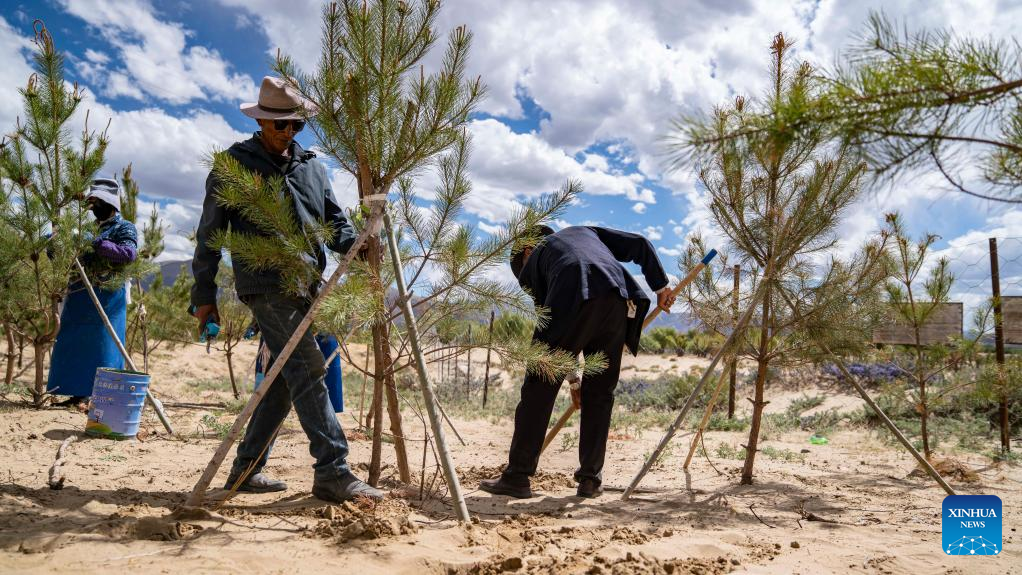
Penjig (R) plants trees with his old partner Toinzhub Cering (C) at the afforestation area by the Yarlung Zangbo River in Zhanang County, Shannan City of southwest China's Tibet Autonomous Region, May 26, 2022.
The middle reaches of the Yarlung Zangbo River, once stretches of barren land with sandstorms raging in spring and winter, now see a sea of green trees all over the place.
With unwavering endeavors of sand control and ecology restoration, more than 45 million trees have been planted over the past four decades in Shannan, an area the Yarlung Zangbo River runs through.
In 1967, Li Chunlu, an agricultural school graduate from northwest China's Gansu Province, was assigned to work in Shannan. On his way to work, the 24-year-old was inundated by the yellow dust in the air. Li thought, at the time, how good it would be if trees could be planted here.
An ambition of planting trees was bred in Li Chunlu as a boy named Penjig from a village by the Yarlung Zangbo River planted a few willow branches on the hillside where he grazed his sheep. The willow branches survived and then grew into willow trees.
In 1982, Li Chunlu shifted his work to the forestry section of the local agriculture and animal husbandry bureau. He tried to start planting trees along the river. However, it was too difficult for the trees to survive due to the drought in spring and winter and the flood during summer and autumn.
In 1984, Li Chunlu and his colleagues finally worked out tree-planting techniques along the riverside, which led to their success of growing about 800 mu (53.3 hectares) of experimental forest.
In the 1990s, the afforestation project was further expanded. Li Chunlu, who was responsible for the forestation work, selected Penjig, who had already grown up as an adult, as one of the team leaders to oversee a tree-planting project because of his relevant experience. Together with 12 villagers, the team was jointly engaged in the restoration project along the river.
Local villagers joined the forestation work as their side business to increase their income at first. Later, they were a lot more motivated to grow trees as they witnessed less sand and agricultural disasters thanks to the afforestation effort. Crop yield has thus been boosted, while pasture has been gradually expanded with more cattle and sheep raised.
In 2004, with the support of the local government, Penjig, who had more than 10 years of experience in tree planting, built his own nursery.
Today, more and more people are taking part in this campaign, and the riverside of the middle reaches of Yarlung ZangBo River has been lush and green. (Xinhua/Sun Fei)
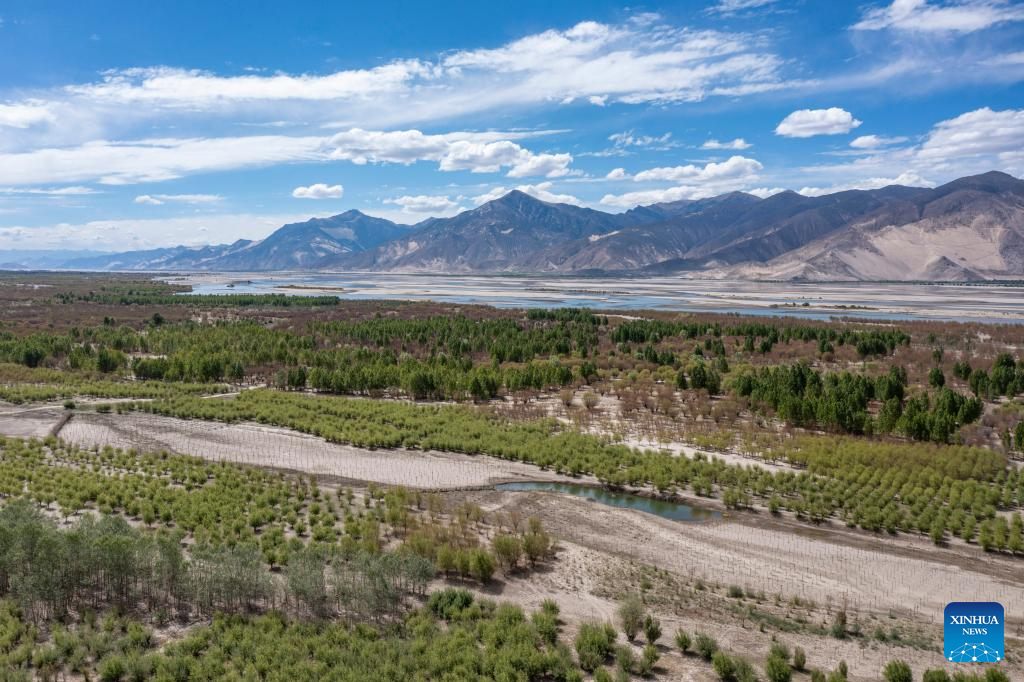
Aerial photo taken on May 27, 2022 shows the riverside of the Yarlung Zangbo River lush with green trees in Shannan City of southwest China's Tibet Autonomous Region.
The middle reaches of the Yarlung Zangbo River, once stretches of barren land with sandstorms raging in spring and winter, now see a sea of green trees all over the place.
With unwavering endeavors of sand control and ecology restoration, more than 45 million trees have been planted over the past four decades in Shannan, an area the Yarlung Zangbo River runs through.
In 1967, Li Chunlu, an agricultural school graduate from northwest China's Gansu Province, was assigned to work in Shannan. On his way to work, the 24-year-old was inundated by the yellow dust in the air. Li thought, at the time, how good it would be if trees could be planted here.
An ambition of planting trees was bred in Li Chunlu as a boy named Penjig from a village by the Yarlung Zangbo River planted a few willow branches on the hillside where he grazed his sheep. The willow branches survived and then grew into willow trees.
In 1982, Li Chunlu shifted his work to the forestry section of the local agriculture and animal husbandry bureau. He tried to start planting trees along the river. However, it was too difficult for the trees to survive due to the drought in spring and winter and the flood during summer and autumn.
In 1984, Li Chunlu and his colleagues finally worked out tree-planting techniques along the riverside, which led to their success of growing about 800 mu (53.3 hectares) of experimental forest.
In the 1990s, the afforestation project was further expanded. Li Chunlu, who was responsible for the forestation work, selected Penjig, who had already grown up as an adult, as one of the team leaders to oversee a tree-planting project because of his relevant experience. Together with 12 villagers, the team was jointly engaged in the restoration project along the river.
Local villagers joined the forestation work as their side business to increase their income at first. Later, they were a lot more motivated to grow trees as they witnessed less sand and agricultural disasters thanks to the afforestation effort. Crop yield has thus been boosted, while pasture has been gradually expanded with more cattle and sheep raised.
In 2004, with the support of the local government, Penjig, who had more than 10 years of experience in tree planting, built his own nursery.
Today, more and more people are taking part in this campaign, and the riverside of the middle reaches of Yarlung ZangBo River has been lush and green. (Xinhua/Sun Fei)
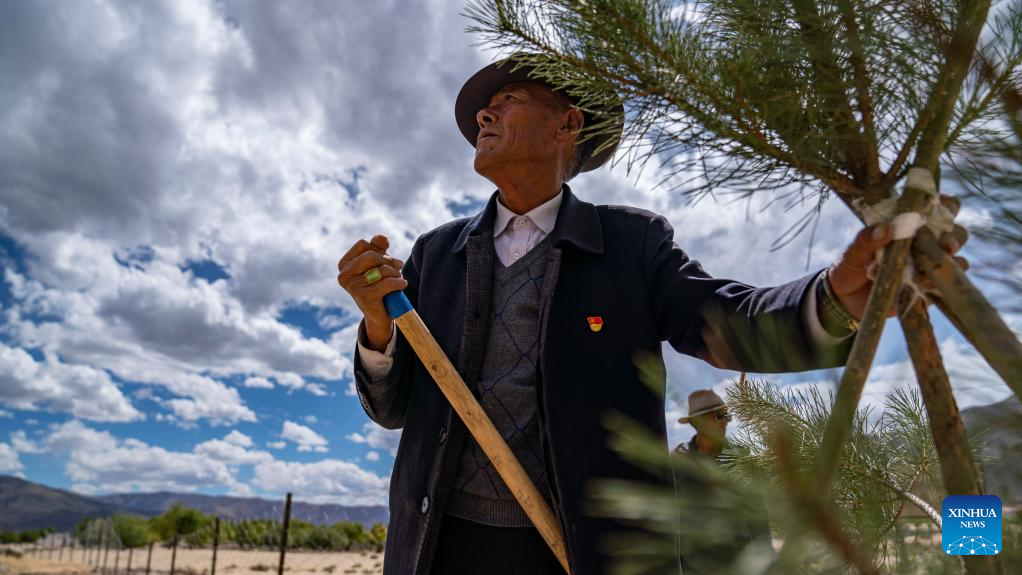
Penjig checks the growth of saplings at the afforestation area by the Yarlung Zangbo River in Zhanang County, Shannan City of southwest China's Tibet Autonomous Region, May 26, 2022.
The middle reaches of the Yarlung Zangbo River, once stretches of barren land with sandstorms raging in spring and winter, now see a sea of green trees all over the place.
With unwavering endeavors of sand control and ecology restoration, more than 45 million trees have been planted over the past four decades in Shannan, an area the Yarlung Zangbo River runs through.
In 1967, Li Chunlu, an agricultural school graduate from northwest China's Gansu Province, was assigned to work in Shannan. On his way to work, the 24-year-old was inundated by the yellow dust in the air. Li thought, at the time, how good it would be if trees could be planted here.
An ambition of planting trees was bred in Li Chunlu as a boy named Penjig from a village by the Yarlung Zangbo River planted a few willow branches on the hillside where he grazed his sheep. The willow branches survived and then grew into willow trees.
In 1982, Li Chunlu shifted his work to the forestry section of the local agriculture and animal husbandry bureau. He tried to start planting trees along the river. However, it was too difficult for the trees to survive due to the drought in spring and winter and the flood during summer and autumn.
In 1984, Li Chunlu and his colleagues finally worked out tree-planting techniques along the riverside, which led to their success of growing about 800 mu (53.3 hectares) of experimental forest.
In the 1990s, the afforestation project was further expanded. Li Chunlu, who was responsible for the forestation work, selected Penjig, who had already grown up as an adult, as one of the team leaders to oversee a tree-planting project because of his relevant experience. Together with 12 villagers, the team was jointly engaged in the restoration project along the river.
Local villagers joined the forestation work as their side business to increase their income at first. Later, they were a lot more motivated to grow trees as they witnessed less sand and agricultural disasters thanks to the afforestation effort. Crop yield has thus been boosted, while pasture has been gradually expanded with more cattle and sheep raised.
In 2004, with the support of the local government, Penjig, who had more than 10 years of experience in tree planting, built his own nursery.
Today, more and more people are taking part in this campaign, and the riverside of the middle reaches of Yarlung ZangBo River has been lush and green. (Xinhua/Sun Fei)

Aerial photo taken on May 27, 2022 shows the nursery run by Penjig in Zhanang County, Shannan City of southwest China's Tibet Autonomous Region.
The middle reaches of the Yarlung Zangbo River, once stretches of barren land with sandstorms raging in spring and winter, now see a sea of green trees all over the place.
With unwavering endeavors of sand control and ecology restoration, more than 45 million trees have been planted over the past four decades in Shannan, an area the Yarlung Zangbo River runs through.
In 1967, Li Chunlu, an agricultural school graduate from northwest China's Gansu Province, was assigned to work in Shannan. On his way to work, the 24-year-old was inundated by the yellow dust in the air. Li thought, at the time, how good it would be if trees could be planted here.
An ambition of planting trees was bred in Li Chunlu as a boy named Penjig from a village by the Yarlung Zangbo River planted a few willow branches on the hillside where he grazed his sheep. The willow branches survived and then grew into willow trees.
In 1982, Li Chunlu shifted his work to the forestry section of the local agriculture and animal husbandry bureau. He tried to start planting trees along the river. However, it was too difficult for the trees to survive due to the drought in spring and winter and the flood during summer and autumn.
In 1984, Li Chunlu and his colleagues finally worked out tree-planting techniques along the riverside, which led to their success of growing about 800 mu (53.3 hectares) of experimental forest.
In the 1990s, the afforestation project was further expanded. Li Chunlu, who was responsible for the forestation work, selected Penjig, who had already grown up as an adult, as one of the team leaders to oversee a tree-planting project because of his relevant experience. Together with 12 villagers, the team was jointly engaged in the restoration project along the river.
Local villagers joined the forestation work as their side business to increase their income at first. Later, they were a lot more motivated to grow trees as they witnessed less sand and agricultural disasters thanks to the afforestation effort. Crop yield has thus been boosted, while pasture has been gradually expanded with more cattle and sheep raised.
In 2004, with the support of the local government, Penjig, who had more than 10 years of experience in tree planting, built his own nursery.
Today, more and more people are taking part in this campaign, and the riverside of the middle reaches of Yarlung ZangBo River has been lush and green. (Xinhua/Sun Fei)
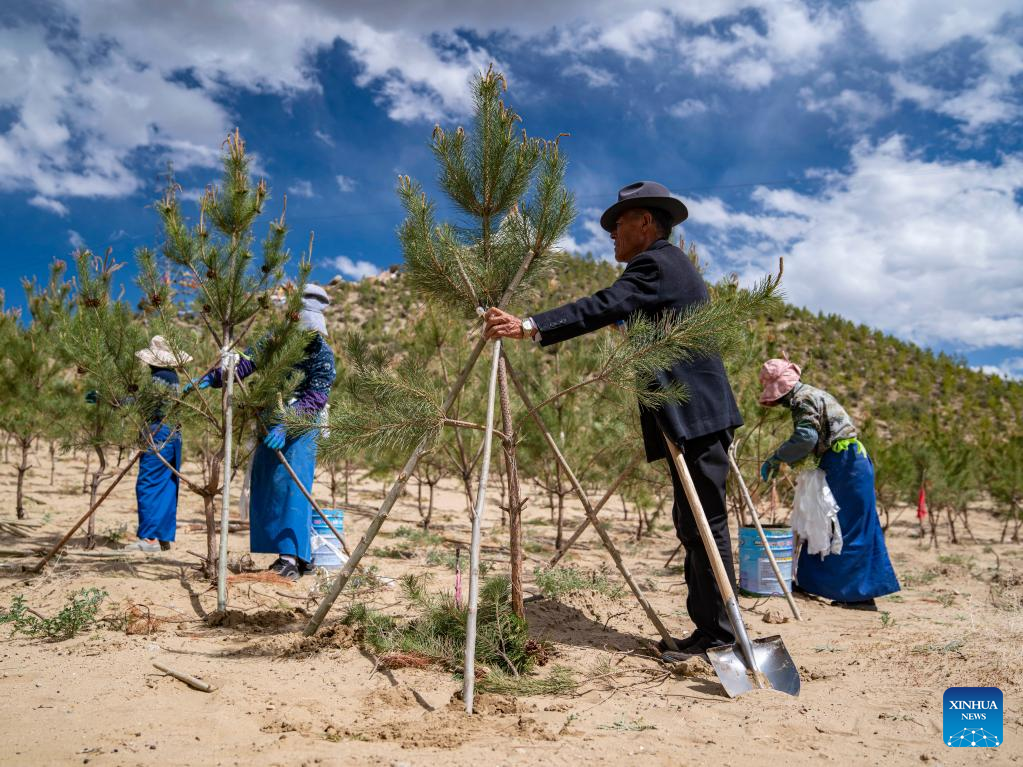
Penjig (front) instructs workers in planting trees at the afforestation area by the Yarlung Zangbo River in Zhanang County, Shannan City of southwest China's Tibet Autonomous Region, May 26, 2022.
The middle reaches of the Yarlung Zangbo River, once stretches of barren land with sandstorms raging in spring and winter, now see a sea of green trees all over the place.
With unwavering endeavors of sand control and ecology restoration, more than 45 million trees have been planted over the past four decades in Shannan, an area the Yarlung Zangbo River runs through.
In 1967, Li Chunlu, an agricultural school graduate from northwest China's Gansu Province, was assigned to work in Shannan. On his way to work, the 24-year-old was inundated by the yellow dust in the air. Li thought, at the time, how good it would be if trees could be planted here.
An ambition of planting trees was bred in Li Chunlu as a boy named Penjig from a village by the Yarlung Zangbo River planted a few willow branches on the hillside where he grazed his sheep. The willow branches survived and then grew into willow trees.
In 1982, Li Chunlu shifted his work to the forestry section of the local agriculture and animal husbandry bureau. He tried to start planting trees along the river. However, it was too difficult for the trees to survive due to the drought in spring and winter and the flood during summer and autumn.
In 1984, Li Chunlu and his colleagues finally worked out tree-planting techniques along the riverside, which led to their success of growing about 800 mu (53.3 hectares) of experimental forest.
In the 1990s, the afforestation project was further expanded. Li Chunlu, who was responsible for the forestation work, selected Penjig, who had already grown up as an adult, as one of the team leaders to oversee a tree-planting project because of his relevant experience. Together with 12 villagers, the team was jointly engaged in the restoration project along the river.
Local villagers joined the forestation work as their side business to increase their income at first. Later, they were a lot more motivated to grow trees as they witnessed less sand and agricultural disasters thanks to the afforestation effort. Crop yield has thus been boosted, while pasture has been gradually expanded with more cattle and sheep raised.
In 2004, with the support of the local government, Penjig, who had more than 10 years of experience in tree planting, built his own nursery.
Today, more and more people are taking part in this campaign, and the riverside of the middle reaches of Yarlung ZangBo River has been lush and green. (Xinhua/Sun Fei)
点击右上角![]() 微信好友
微信好友
 朋友圈
朋友圈

请使用浏览器分享功能进行分享
